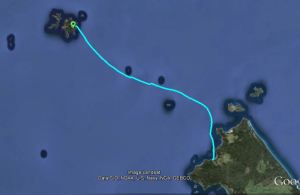Friday 27 December 2013
To most eyes, this is not a great photo. To me, it speaks volumes.
It’s not yet 5.00am, I’ve had four hours sleep, my kayak is loaded, I’m set. I look at my kayak, I look into the sea mist and the dark, and I know. I just know that I can do this. I can kayak across from Deal Island to Flinders Island today. Minimum of 60 kilometres. This crossing could take 12 hours, I am prepared for 14 hours. Perhaps more. I know.
First two hurdles, minor really, launch in the dark into small surf, and the bommie just outside Winter Cove, I am fixated on not paddling over that in the dark.
It starts, the longest crossing.
The weather forecast is in our favour. Fortunately, the five days have been in our favour. Just as our readings and interpretations of the forecasts we’d read last Sunday had predicted. Tomorrow, Saturday, is another story, and the days following. Our ‘window of opportunity’ is perfectly timed.
The sun rises, briefly a red-golden orb, then lifts into the sea mist. It’s not long before the mist engulfs Deal Island behind us, and it hides Flinders Island for most of the day. So there is a wonderful feeling of being truly out there, no land in sight, just us two and the occasional soaring albatross. With our day broken into hourly timeslots, I have a good day. There are two hours where I am not enjoying myself, and apart from that, life is sweet.
Wrights Rock makes itself apparent, both by sight and sound. We skirt west and south of it, about 500m from it, not tempted in closer by the raucous seals, sounding as if it is a Saturday-night-on-the-town.
At our halfway point, 30km from Deal and 30km from Flinders we take our hourly break, and are cheered by a pod of dolphins. Conditions are so benign that I stretch my legs.
I fantasise…
… so tired am I that I develop a plan for Killiecrankie: land, immediately set up the tent, crawl in, place the supply of chocolate and Christmas cake alongside my sleeping bag, sleep, when I wake up hungry, eat from those two sources.
… and for the ongoing journey down the west coast of Flinders, we’ll have days of 20-30km, stopping for leisurely lunches on pristine beaches bathed in warm sunlight, setting up camp early in the afternoons, perhaps even having a late morning launch. (Neither fantasy come to fruition).
Eventually we skirt north and east of Craggy Rock. It surprises me, arising suddenly out of the mists, steep and green and, well, rather craggy. Our navigation for this crossing swings us first west then east, in an elongated S shape, bringing the total number of kilometres for the crossing to 66. The crossing takes ten and a half hours.
Light winds develop and we release our sails. It’s just so much fun, we head further east than we should, enticed by the outline of the Sister Islands coming out of the mist. Eventually we focus on our goal, Killiecrankie Bay, adjust our heading, cross over and through some bouncy tidal areas. My mind plays tricks, not believing that our landing spot is actually now in view a few kilometres away, I brace myself for having to round a headland.
As I paddle onto the sands of Killiecrankie Bay, an island man stands waiting, his hand out to shake mine, “Welcome to Flinders Island.”
[Apologies for the ego-centric nature of these photos, Harry had the camera all day]
Crossing Bass Strait
Trip Day 5
Paddling Day 4
Friday 27 December 2013
Distance covered: 66km
Launched: 5.00am
Landed: 3.30pm












All the things we learn paddling over the years, forward stroke, boat control, self rescue, group management, packing, trimming your boat, reading weather, rough water handling, conditioning, fuelling, you name it, all come together for the blissful experience of a long committing open water crossing. It really is the most awesome thing any paddlers ever do….